FLIR First Mate, thermal in your hand
A significant product introduction at the NMEA Conference was the FLIR First Mate, a hand held thermal camera that’s truly designed for marine use and will list for a hair under $3,000. Mind you, it does not use light intensification technology, or a near IR illuminator, like most every other marine night vision monocular. This is the real thermal deal, able to see long wave infrared radiation that has nothing to do with visible, or near visible, light. Like the FLIR M-636 I’ve begun testing, it can see in total darkness, and even in broad daylight it often sees in a usefully different way than your eye. For instance, a MOB is going stand out like a light bulb regardless of water or skin color. FLIR being FLIR, they took us all out on San Carlos Bay with a boat load of First Mates and other thermal cams…
Thus I can tell you that the First Mate has a nice hand feel, and is easy to master. The $4,000 pro model does have controls to enable 2x digital zoom and capture screens like the ones below, but the base model just has on/off, image polarity (white hot or black hot) and screen brightness controls. The field of view is 24 degrees wide, about 3.5 times that of standard 7 x 50 boat binocs, so finding something out there is easier than you might think, and lens jiggle doesn’t seem a problem.
I believe both the screens below, gotten from FLIR, were taken from the same high vantage point, and have had their resolution bumped up from the thermal sensor’s 240 x 180 pixels (maybe that happens right in the First Mate), but the detail seems quite close to what my eye saw through the monocular from the boat’s top deck. The day beacon in the first image is reported to be 650 yards away, and is probably right across from the resort we stayed in (visible, along with the mangrove islands, here on Google Maps).
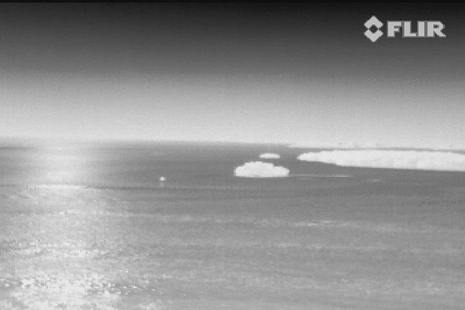 The screen below was definitely taken from the hotel, and possibly during the day, given how warm those wooden dock surfaces appear. But I know for sure that you would see pretty much the same image no matter what time of day it was. And, having attended the thermal vision seminar at NMEA, I’m learning to understand some of the subtleties. Every thing warmer than absolute zero emits long wave thermal radiation, often in proportion to its actual heat, but not always so. Some materials are better emitters than others, and I guess the black Simrad lettering on that demo boat is a poor emitter, as is that metal roofing. Reflections are also a factor in thermal vision, and hopefully I can capture some examples in my M-series testing.
The screen below was definitely taken from the hotel, and possibly during the day, given how warm those wooden dock surfaces appear. But I know for sure that you would see pretty much the same image no matter what time of day it was. And, having attended the thermal vision seminar at NMEA, I’m learning to understand some of the subtleties. Every thing warmer than absolute zero emits long wave thermal radiation, often in proportion to its actual heat, but not always so. Some materials are better emitters than others, and I guess the black Simrad lettering on that demo boat is a poor emitter, as is that metal roofing. Reflections are also a factor in thermal vision, and hopefully I can capture some examples in my M-series testing.
I have little doubt, though, that a First Mate could be useful to navigation, and also to security around a marina or waterfront. And maybe for other uses. If I get to try one up here, for instance, I’d see if it would reveal the heat leaks in my house, or the skunks and coons in my back woods, and I’d also look for hot spots around Gizmo’s power panels and battery banks. But FLIR makes no claims for these sort of uses, particularly the latter, noting that while the thermal sensor is the same as used in some of its thermography products, the First Mate’s optics are optimized for objects beyond 30 feet and its image processing for contrast. Still, who wouldn’t want one (given a generous gadget budget)?


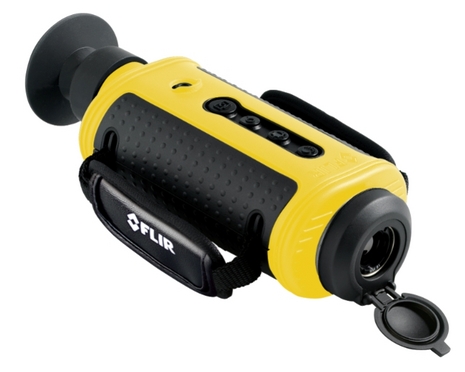
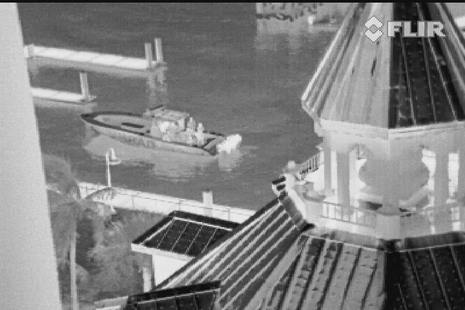
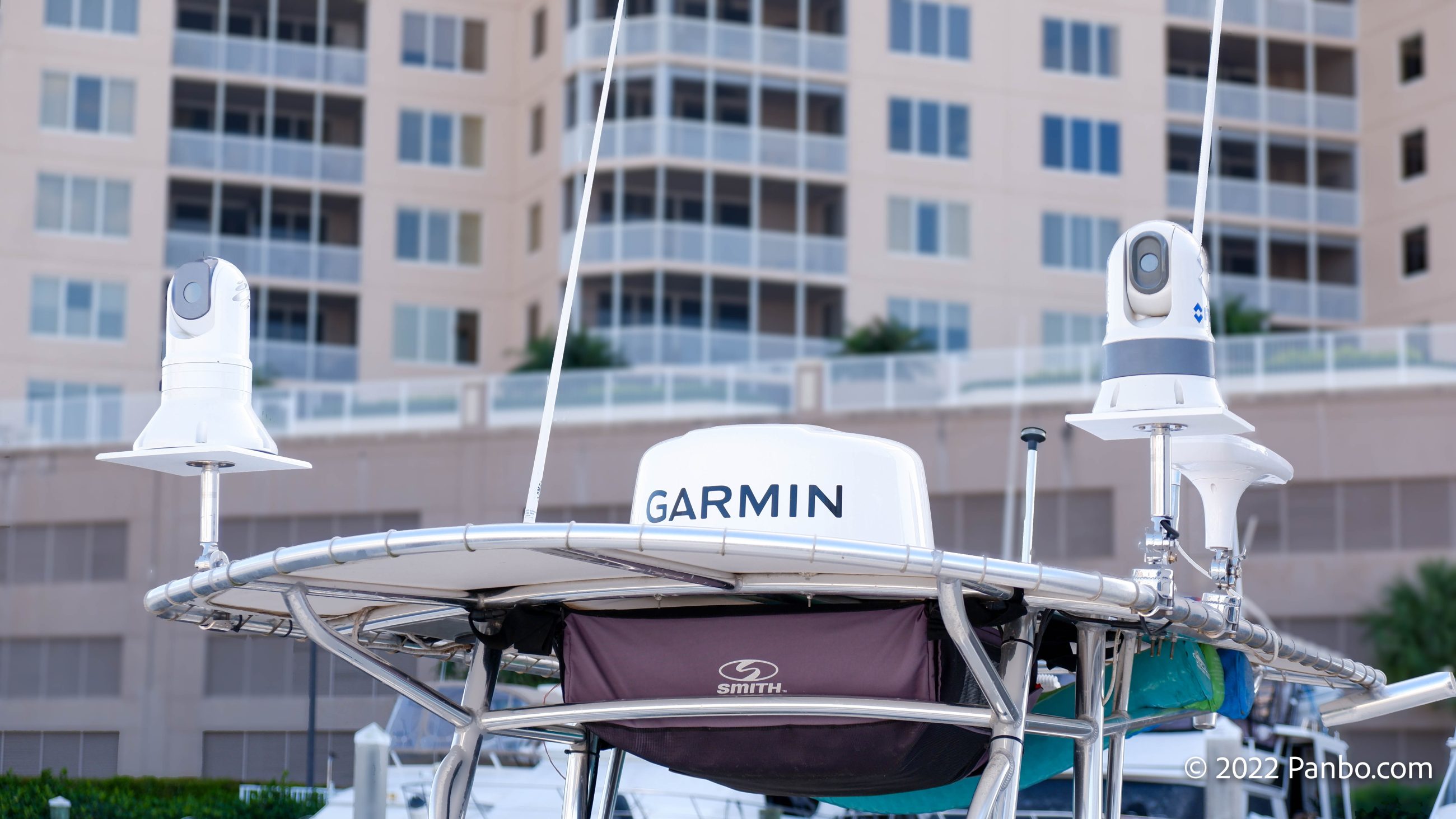

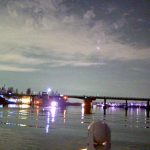








Ben, the images were both taken from my 7th floor balcony with a “First Mate Pro” at approximately 5pm the afternoon of the cruise. Except for the reflection of the sun on the water in the top picture, the image looked the same at night.
Having used FLIR in the military for quite a few years, the first thing to consider is FL means “Forward Looking,” so, this is really just an IR Monocular.
If we really are going to understand it’s utility, it needs to be tested in conditions where visible light tells one nothing or worse, the wrong thing.
We “owned the night” because of what we could do in the dark, but many of us were even happier to own the dust, haze, and light fogs. Do you have any pictures/data showing visible and IR side by side?
Also be aware it takes very little rain to render these devices useless.
Afloat the one time IR really saved the bacon was when we saw several hundred feet of unlit dredge pipe floating across an unlit unmarked channel on a moonless night.
In the air, one night we had to make a parachute drop and IR allowed us to see the cows butts were facing the NE. The told us where up-wind was.
Right, to a long wave thermal camera, water is opaque. But I’m curious what that means in the real boating world. A couple of weeks ago, for instance, the M-Series saw fine through some fog remnants that shrouded the upper half of Mt. Battie (see testing link above). That could equate to seeing an island obscured by ‘light’ fog.
I fully expect dripping wet fog and heavy rain to obscure the thermal camera, but I hope to see how badly and where the line. I will try to document what’s visible and what’s thermal, but that’s a challenge.
Right, to a long wave thermal camera, water is opaque. But I’m curious what that means in the real boating world. A couple of weeks ago, for instance, the M-Series saw fine through some fog remnants that shrouded the upper half of Mt. Battie (see testing link above). That could equate to seeing an island obscured by ‘light’ fog.
I fully expect dripping wet fog and heavy rain to obscure the thermal camera, but I hope to see how badly and where the usability line is. I will try to document what’s visible and what’s thermal, but that’s a challenge.
Do Ireally need to spend $3G to see crab pot floats?
Hell no, Sandy. Our own innate night vision is pretty good if treated well. That’s one reason I like using a flying bridge — head up and eyes unimpeded by glass or anything else. And one thing I’m checking out in the night testing is how well these various screens dim down and/or go to red. Plus I’ve got tape on hand for annoyingly bright LEDs.
But if you want a great tool to improve on what the good lord gave you, and you have the means, a thermal cam is a real contender.
Ben, what we found using eye-slaved FLIR in fogs was interesting. Motionless targets were usually indistinguishable. The fog looked a bit brighter, but it was a very nuanced brightness. Moving targets did better. The physics of it all don’t answer why. We came to the conclusion it’s an atavistic response to “movement means what’s moving is dinner, or you are about to be.”
And I’m talking IR units with far better thermal discrimination and aperture than this one.
If I could design my ideal, it would be a pair of stabilized binoculars with IR on one side and Gen III LI on the other and the ability to mix the images from 0-100% from either side.
But that would probably cost more than my dink and liferaft combined.
OBTW, one can get about the same performance as First Mate from a “weather-proof” home IR security camera for about $1400
ANeblig:
ATN offers a product that partially meets your ideal. No stabilization and no variable mixing, but you do get thermal + Gen 3 NV, one in each eye:
http://bit.ly/16QRMr
$13,000 ain’t free, but hey, you get free shipping!
/afb
OK Folks,
I am just beginning to research night vision technologies.
I am sail boater.
What are the advantages and disadvantages of a FLIR monocular?
What are the advantages and disadvantages of a Gen II or Gen III IR monocular?
Thanks in advance.
I have used both a Gen 2.5 and Gen 3 NV scope. The scope is not that useful coming into a harbor or slip, as any of the lights, however dim, render the scope almost useless. For example, a small light on the end of the dock, a restaurant on shore, a home lit at night will make it useless.
It works best when it is near pitch black, and the only light is from the stars or a dim moon.
Turning down the image intensifier is not a reliable way to deal with bright lights. It is not reproducible, and you cannot use it efficiently or quickly when you need it.
Thanks, Keith. I haven’t used light intensification in some time (like decades), but do remember being both impressed that I could see unlit nav aids as we entered Fort de France at midnight, and annoyed about the flaring and trails of background city lights.
By contrast, I was out today in bright, but low sun, fall Maine conditions and noticed that the FLIR thermal cam could nicely image pot bouys and nav aids that were otherwise very hard to see in the sun’s glare line.
Hello all,
Can someone tell me if its possible to export this unit. I want to use it for boating (I live in caribbean, Curacao).? If not I guess I can always pick it up or let it mail via my DHL PO BOx in miami right? I love this unit it has all the things I want, and the right pricetag!
Kind regards,
Mark
I am a Captain off the Nigerian Coast. Pirates are a constant threat in fact just two nights ago a good friend of mine was boarded and he and his crew were beaten to a pulp then had his boat ransacked and anything not bolted down was stolen. They tend to use fast fiberglass boats about 15 to18 feet long. and don’t hesitate to shoot at the boats they are going after. My friend and his crew were very lucky. Does any one think this product would be worth the money for early detection and possible early deterrence? we are able to secure the vessel if time permits. but thats usually the problem they are on you before you know it. I am thinking about buying one, testing it then trying to sell the idea to my company we have 12 boats in Nigeria and about 200 all over the world. Any feed back would be greatly appreciated.